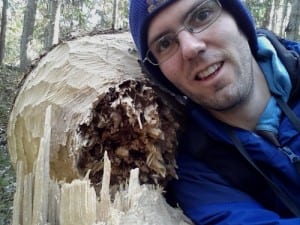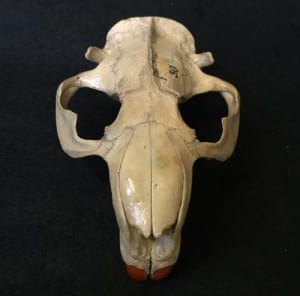Specimen of the Week 230: The Beaver Skull
By Jack Ashby, on 11 March 2016
It is purely coincidence that Specimen of the Week 230 – the number most associated with going to the dentist [tooth hurty. Apologies.] – is an animal famous for the incredible feats of its teeth.
Beavers can cut down huge trees, owing to the superb adaptations of their skulls.
Like squirrels, but at the bottom of trees
As members of the squirrel-like rodent group Sciuromorpha, beavers have massive, ever-growing, self-sharpening front teeth. Rodent incisors are often differently coloured on the front and back. The orange substance on the front side is super hard enamel, while the back is unusually exposed dentine (a softer material which fills the inside in most teeth). When rodents bite on hard material, or even by biting their top teeth against their bottom teeth, the dentine erodes away at a faster rate than the enamel, essentially sharping the “blade”.
Long in the tooth
Given that they are constantly grinding away bits of their teeth to keep them sharp, they have an amazing adaptation that allows them to re-grow continuously. Their teeth are open-rooted, unlike ours which come to a definite end point. For us, the cells which deposit enamel (ameloblasts) die once our teeth have developed, but for beavers they keep beavering away throughout the animal’s life. This allows for the constant wear that results from biting hard wood, by continually replacing the enamel from the bottom.
Tooth or dare
The dams that beavers build by felling and dragging trees create ponds that allow beavers to safely move around their habitat to access their food. The ponds act as moats around their lodges (also made of felled trees), protecting them from predators. Beavers eat the bark, shoots and leaves of the trees they cut down, and also water plants that grow in the wetlands they create.
What a cheek!
The huge gaps between the cheek bones (zygomatic arch) and the skull proper are spaces for the sizable jaw muscles required to cut through wood, and the ridges of bone at the top and back of the skull increase the surface for these muscles to attach. Also, the cheek bones themselves are really deep and wide, allowing for extra huge masseter muscle involved in chewing. In zoology, the correct term for these cheek bones is “weird”.
Beaver breather
Enough about teeth. If you ever see a skull with eyes, noses or ear openings on the top of their skull, it’s a good sign they like getting wet. Beavers swim with the tops of their heads just above the water, so they can see, breathe and hear. The bony tube of the ear (the external auditory meatus) extends upwards and outwards from the skull in a way that is far more pronounced than in any other skull I can think of. It gives them the appearance of alien-like antennae.
Hard to swallow
When you swallow, a flap of tissue at the back of your throat (the epiglottis) flips over the top of your trachea to stop things getting into your lungs. Unusually, a beaver’s epiglottis is at the back of its nose, not its mouth. A beaver can hold the back of its tongue tightly against its palate, blocking the passage of water from the mouth. This allows the beaver to open its mouth underwater, to gnaw or carry branches – a crucial trait for being a beaver.
Jack Ashby is Manager of the Grant Museum of Zoology
3 Responses to “Specimen of the Week 230: The Beaver Skull”
- 1
-
2
Jennifer von Reis wrote on 20 April 2020:
Thank you Jack Ashby for this description. I just found the top part of a beaver skull and was amazed at the ear bones protruding from the top. Also on the upper part of the palate there are two slits through the bone. Are these the area blocked by the tongue when swimming? The picture of the beaver swimming was very helpful in understanding this skull!
-
3
Christopher Baldwin wrote on 18 June 2021:
Hi Jack
I need your email address. I have a fairly comprehensive mammalian key that I will send youChristopher Baldwin
Leading Expert in North America in
Mammalian Skulls
 Close
Close






Handling a beaver skull I notice the ear bones are loose and wiggle freely within the skull unlike any other skull I’ve observed (which are generally fused solid to the rest of the skull)
What function does this wiggle room assist the beaver with in hearing or assessing pressure????